How Does Business Process Automation Work?
Business process automation works by integrating various software applications to perform tasks that would otherwise require manual intervention. This can include anything from data entry to customer service interactions.
Most platforms have a no-code or low-code environment in which users can replicate their process workflows digitally and automate them end-to-end. Oftentimes, the digital workflow will include other automation solutions such as AI-image recognition (e.g., for reading invoice PDFs) or machine learning (e.g., for matching unstructured data).
Advanced tools like Transformance do not only integrate different software to sync data fields but apply AI and machine learning to cleverly insert business logic to processes at scale. Its latest feature lets you prompt an AI co-pilot to generate process steps and entire workflows without needing any coding and only limited data analytics skills.
The Benefits of Business Process Automation
As we discussed in the introduction, business process automation is an important emerging trend that more and more enterprises adopt. Here are the 5 major reasons why businesses adopt business process automation tools and why you should consider doing the same.
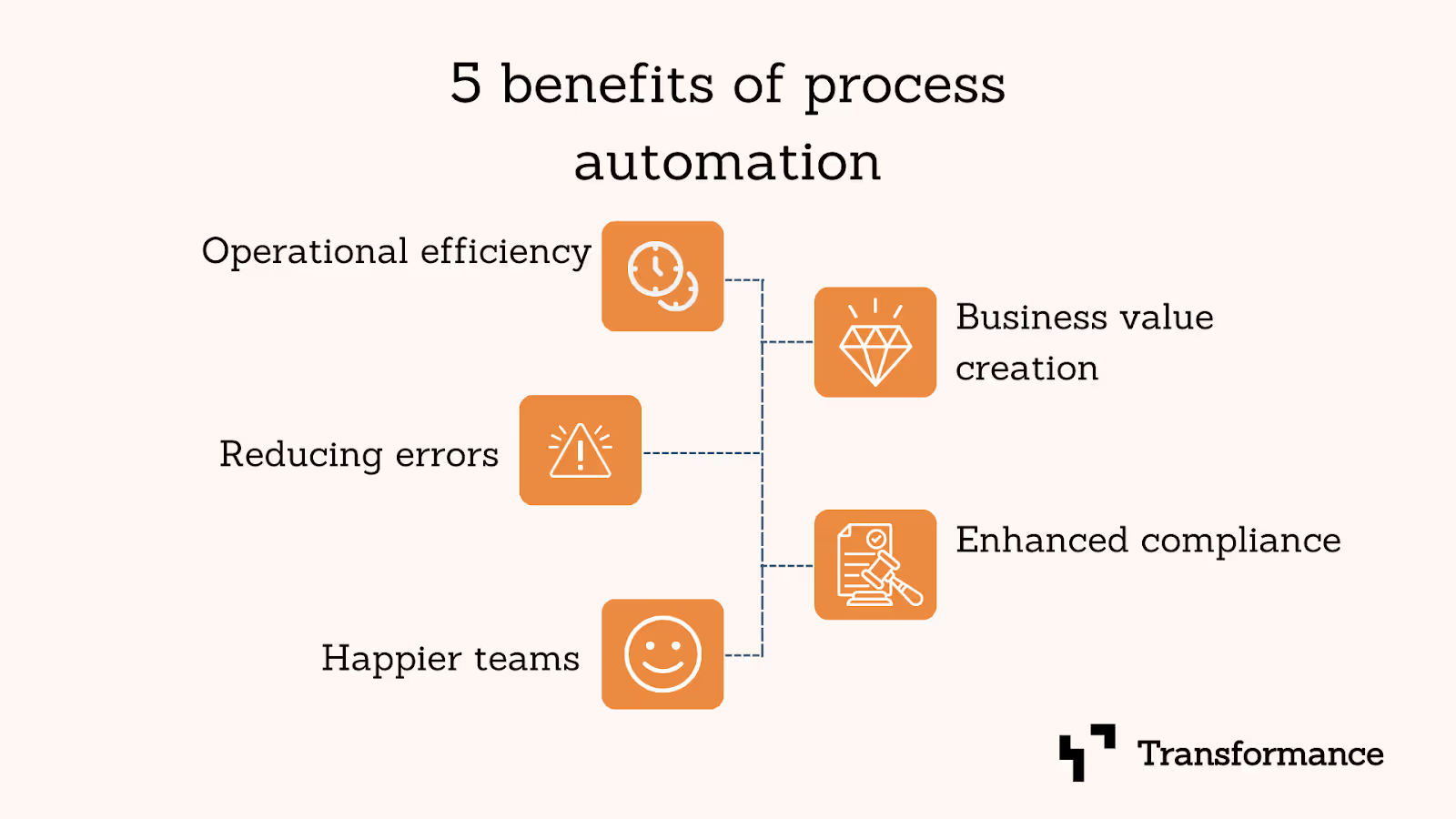
Increase operational efficiency
When speaking to executives about why they need more automation in their business, operational efficiency is the most quoted.
Business process automation enables teams to streamline their processes by automating repetitive tasks while reducing manual effort and errors. This results in faster turnaround times for all team projects and ongoing to-dos. The more a process is automated and standardized, the faster high quality information and data can flow through the enterprise. A study by Gartner reports that automation could save up to 30% of a full-time employee’s time in the finance department. This equates to 25,000 hours annually, potentially saving $878,000 for an organization with 40 full-time accounting staff.
Create business value
One of the most significant benefits of business process automation is its ability to free up valuable human resources. By automating routine tasks, teams can not only reduce the time spent on repetitive tasks but also redirect their efforts towards more strategic initiatives, fostering innovation and driving growth.
Mckinsey’s research found that automation and AI will change the amount of time spent on various activities. For example, the amount spent on basic cognitive skills, such as data input and processing, will decrease by 15%. Similarly, hours spent for physical and manual skills are expected to decline by 14%.
Such studies indicate that automation can enhance productivity by saving time from manual tasks, allowing employees to focus more on complex, creative, and critical decision-making activities making your enterprise more agile and innovative as a result.
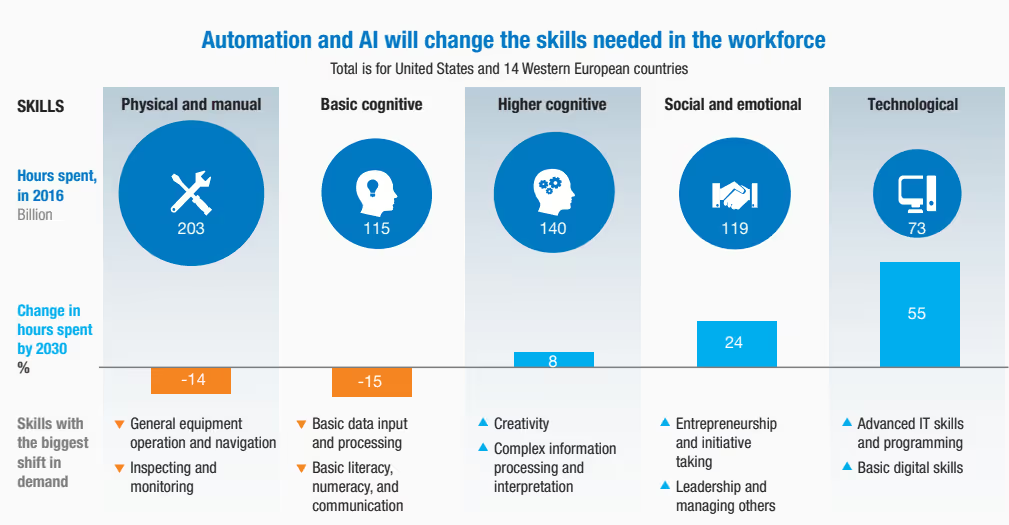
Reduce errors and improve data consistency
Be it in posting your SAP CATS timesheets or finance journal entries, business process automation can help you maintain better data quality throughout your ERP and in all the adjacent systems in your enterprise. Because machines and code do not fall victim to many weaknesses of us humans, business process automation tools can help your teams reduce errors and thus enhance data quality throughout your organization.
In addition, the increased efficiency of processes explained above, ensures that this accurate and consistent data is available faster and can thus have more real-time impact.
Enhance compliance and risk management
Compliance and risk management are important for all enterprises and by extensions for their automation processes. Especially the Finance, Accounting, and Controlling but also HR and procurement data is crucial to enable comprehensive audit-trails and guarantee, e.g., tax compliance. Processes which are too manual can increase compliance risks where data trails become inconsistent and human error leads to data breaches.
By automating repetitive tasks and assuring fast and consistent data flows, business process automation enhances compliance and risk management for all enterprises regardless of their IT landscape.
Create happier teams
Last but certainly not least, smoother processes and reduced dependency on complicated VBA or Excel models lead to happier teams. In a 2021 survey, Salesforce found that “89% [of employees] are more satisfied with their job and 84% are more satisfied with their company as a result of using automation in the workplace”. The following chart shows the satisfaction across teams - while teams like IT lead the pack in terms of satisfaction, even the lowest ranking team - accounting and finance - counts 4 in 5 of its members more satisfied than without automation.
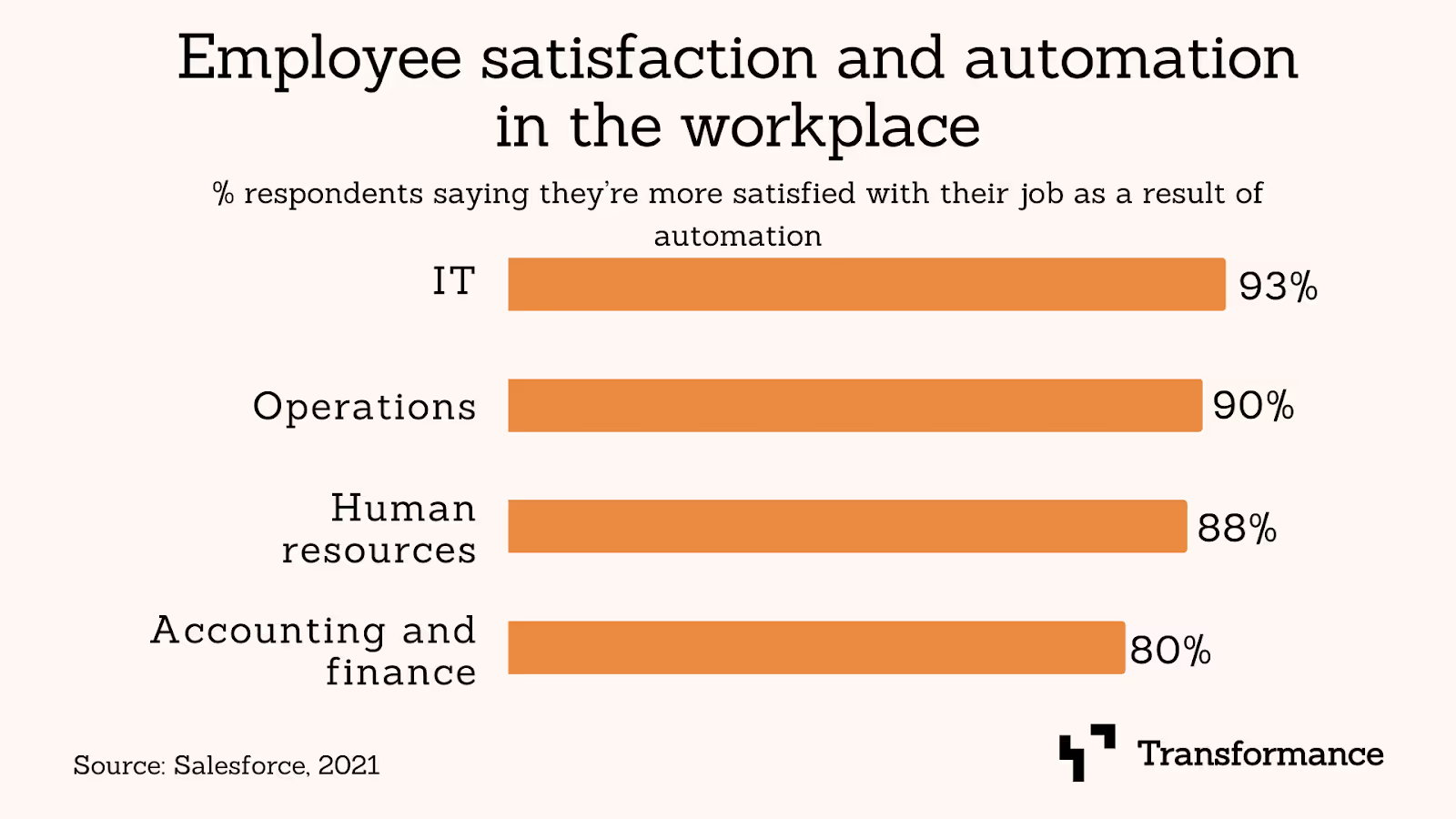
Business Process Automation Use Cases
Finance automation use cases
Finance is among the most comprehensive and complex functions in any enterprise. Most other functions and processes eventually lead to Finance as it manages the General Ledger (GL), Accounts Payable (AP), Accounts Receivable (AR), Cash Management, and Reporting and Analyses (FP&A).
Within the wide breadth of finance processes, specific requirements and limitations need to be taken into account when considering business process automation.
For GL processes, journal entries (e.g., in SAP) are most important to optimize and automate. The journal entry format in systems like S/4 HANA can be extremely specific, and only advanced tools like Transformance enable automated posting from diverse sources with a simple text prompt.
AP automation is mainly aimed at increasing the processing speed of invoices and purchase orders (POs) to improve vendor relationships. AR automation covers the entire order-to-cash (O2C) process to ensure that sold products and services result in timely cash flow. Both AR and AP optimization are key for improving a company’s working capital.
FP&A processes must enable the business to have full, near-real-time visibility into their data and KPIs so the business can make decisions and improve financial planning faster. Especially comprehensive data transformation (ETL) capabilities are important to ensure data is clean, comprehensive, and actionable. Best-in-class AI-native automation platforms like Tranformance include ETL capabilities in their platform.
IT automation use cases
IT is the backbone of all digital tools and processes in any company. The team ensures that applications are running, data is flowing, and users are enabled to add business value.
IT KPIs include uptime of IT assets, incident resolution time, and security compliance. Business process automation can improve all of these core IT KPIs.
Monitoring and performance management can be improved by leveraging advanced tools to automate health checks, performance tuning, and proactive issue resolution. Effective business process automation tools will also enhance processes and integrations with third-party tools to ensure better outcomes.
Data integration can be achieved using various tools to ensure seamless integration between different systems. However, some tools may have limitations, including usability and cost. Alternatives like Transformance can help teams integrate and automate data from various sources more easily and quickly.
Incident management needs to ensure that service level agreements (SLAs) are adhered to throughout the IT organization. Faster incident tracking and the integration of core systems like JIRA and ServiceNow are essential to ensure teams can focus on solving issues rather than tracking them through various different systems.
Procurement automation use cases
Procurement is a critical function in any organization. Various tools and platforms offer modules that automate much of the procurement process.
The core procurement processes include supplier onboarding, PO processing, invoice reconciliation, and contract management.
Supplier onboarding can be largely automated using specialized tools, but these tools are often seen as clunky and difficult to use by suppliers. The core goal of business process automation should be to make this process as fast and efficient as possible.
PO processing is an essential procurement process whereby the creation, tracking, and approval of purchase orders should be as fast as possible to streamline procurement cycle times. Many business process automation tools include PO processing workflows.
Invoice reconciliation describes the matching of invoices, POs, and goods receipts to reduce discrepancies and improve payment accuracy. Modern tools include matching algorithms to match even more unstructured documents like PDF scans with OCR and other machine learning.
Lastly, while all of the above can be done using various platforms, systems like Coupa are becoming more popular as they cater even better to the needs of procurement teams. Business process automation tools should thus ensure that data can flow quickly, accurately, and efficiently between different systems to avoid internal conflict with Finance and other teams.
HR automation use cases
Human Resources (HR) processes touch all prospective, current, and often former employees of a company. Various tools and platforms cover recruiting, HR, and payroll, as well as managing employee expenses, travel, and perks.
In these areas, a variety of business process automations exist. However, many users struggle with automating processes like timesheet postings or payroll processing, especially for service businesses that often need a variety of integrations to accurately and efficiently post and bill their service charges.
While many platforms include a lot of functionality, many companies opt for HR systems like Replicon or Workplace. Automating and integrating such tools with core enterprise resource planning (ERP) systems using AI platforms like Transformance is essential to ensure teams can work efficiently regardless of their tech stack.
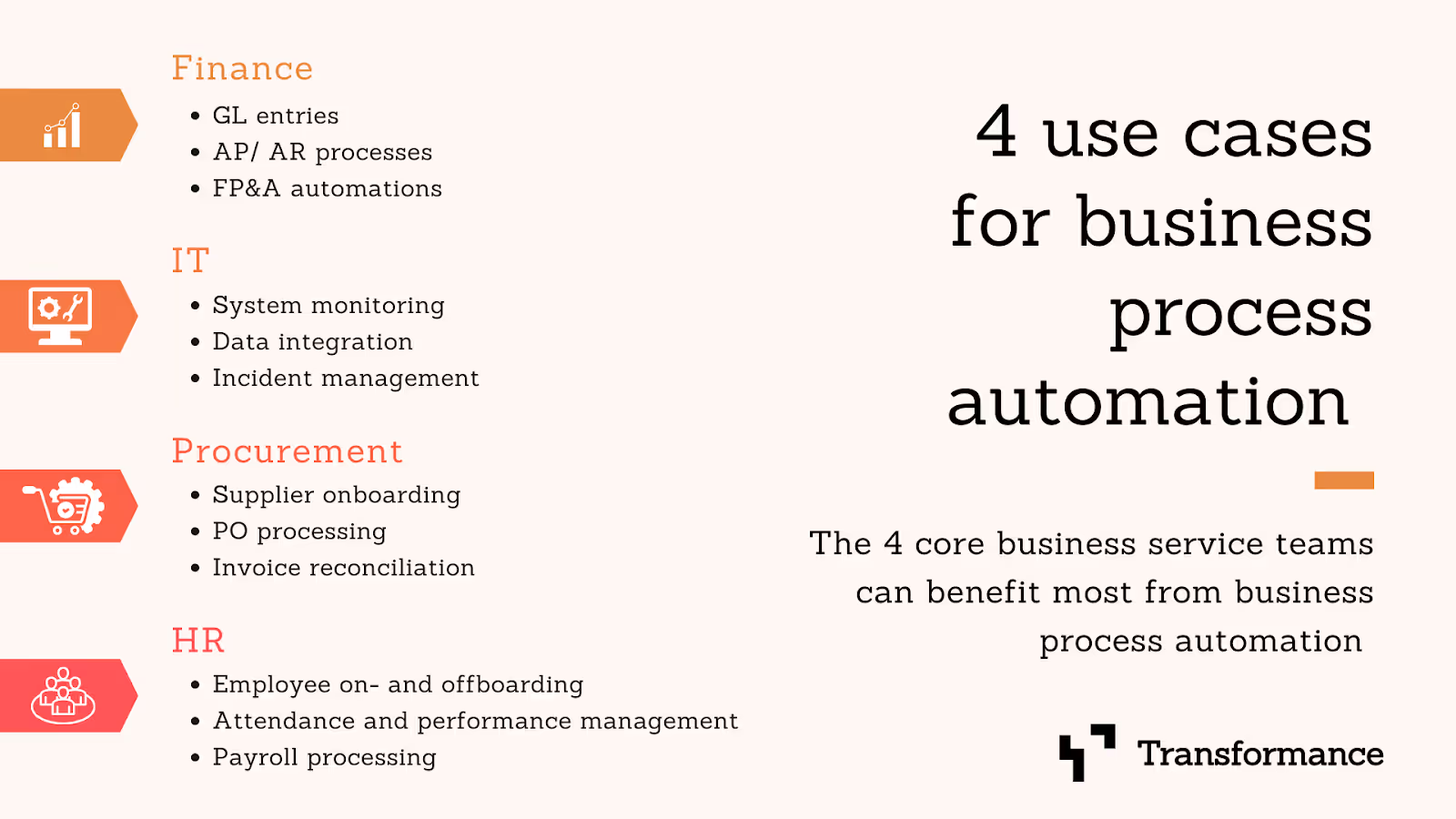
What to Look for in a Business Process Automation Solution
Ease of Use
Look for a solution that is user-friendly and doesn’t require extensive technical knowledge. AI agents like Transformance are ideal as they allow you to automate processes without writing a single line of code. Their new AI feature even allows you to create integrations, transformations, and apps at scale just using speech inputs.
Scalability
Your business process automation solution should be able to grow with your business. Easy setup, simplicity of use and cloud-readiness are essential to enable scalability. Moreover, integration and tailoring capabilities will be tantamount to starting a successful automation journey.
Integration Capabilities
Choose a solution that is flexible to integrate with your existing systems and software. This ensures a seamless workflow and maximizes the benefits of automation. Tools like Transformance can create any integration at scale thanks to clever use of AI.
Total cost of ownership and ROI
Consider the vendor’s pricing model and the total cost of ownership, including any hidden fees or long-term costs. Make sure the pricing aligns with your budget and offers good value for the features and services provided. A per-user and per-process pricing model is standard in the industry as it is directly linked to the benefit for each process and the number of people it touches.
Looking to select a BPA vendor? Check out our article “11 Tips for choosing the right business process automation software”
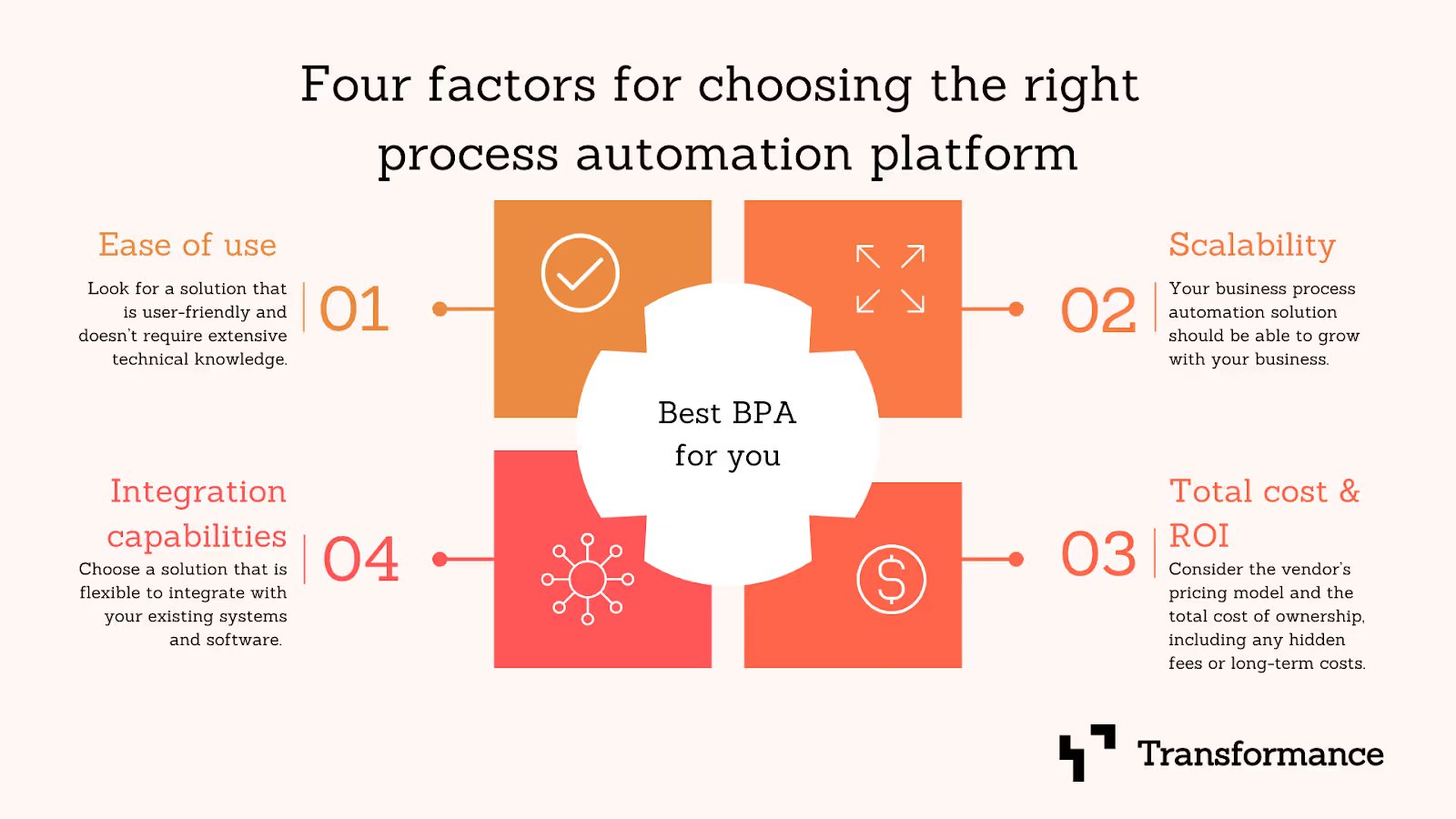
The future of Business Process Automation and Artificial Intelligence
Artificial Intelligence (AI) is on top of the agenda for most businesses. Fully 92% of enterprise software buyers are considering AI-powered software according to Gartner.
But separating the hype from reality is often hard for business leaders as oftentimes the value of AI pitched by vendors exceeds the real added benefit on the ground. It comes as no surprise that “only 5% of businesses surveyed have used AI in the past fortnight” according to a survey by the Economist.
AI is undoubtedly transforming the future of work in global enterprises. Transformance stands at the forefront of this revolution with its AI-native capabilities. Unlike vendors that limit Generative AI (GenAI) integration to simple text prompting, such as interfacing with ChatGPT, Transformance leverages its advanced AI-driven agent to empower users to design and deploy full-stack transformations, seamless integrations, and custom process applications using natural language inputs.
This groundbreaking approach not only accelerates solution development but also eliminates the reliance on internal or external IT resources. By combining speed, scalability, and simplicity, Transformance redefines what enterprises can achieve with automation and AI.
Curious about how AI can elevate your automation journey? Book a free consultation today to explore the possibilities with Transformance.
Summary: what is business process automation?
Business Process Automation is a powerful tool that can transform your business operations. By automating repetitive tasks, you can increase efficiency, reduce costs, and improve accuracy. Key benefits include efficiency, cost savings, better data accuracy, and overall team and customer satisfaction.
With AI-native business process automation solutions, like Transformance, you can unlock revolutionary value by building full-stack custom applications and seamlessly automating complex workflows through natural language inputs. This approach enables enterprises to focus on innovation and growth while eliminating traditional IT bottlenecks.
If you want to find out more about business process automation and how Transformance can help you achieve your automation goals, book a free consultation!
FAQs
Q: What is Business Process Automation? A: Business Process Automation (BPA) is the use of technology to automate complex and repetitive business processes.
Q: How does business process automation work? A: Business process automation works by integrating various software applications to perform tasks that would otherwise require manual intervention.
Q: What are the benefits of business process automation? A: The benefits of business process automation include increased efficiency, cost savings, improved accuracy, and enhanced customer experience.
Q: What are some common use cases for business process automation? A: Common use cases for business process automation include financial services, human resources, and manufacturing.
Q: How does AI enhance business process automation? A: AI enhances business process automation by enabling systems to learn and adapt, making processes even more efficient.
Q: What should I look for in a business process automation solution? A: Look for ease of use, scalability, integration capabilities, and robust security measures.
Q: How do I get started with business process automation? A: Start by identifying time-consuming and error-prone processes, then choose a business process automation solution that fits your needs and budget.






